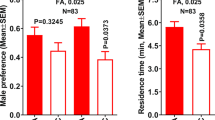Abstract
Lures containing different amounts of (E)-10-dodecen-1-yl acetate and (E,E)-8, 10-dodecadien-1-yl acetate were formulated in natural rubber stoppers or polyethylene vials and tested in traps in the field to establish relative attractiveness to males of the pea moth,Cydia nigricana (F.), dose-response relationships, and the effects of weathering. Initially, both formulations of (E,E)-8,10-dodecadien-1-yl acetate were much more attractive than those of (E)-10-dodecen-1-yl acetate, but their activity diminished considerably after only 5 days in the field because an inhibitor was formed, and polyethylene formulations were not attractive after one week. However, lures containing (E)-10-dodecen-1-yl acetate, with or without antioxidants, in both rubber and polyethylene were still attractive after three months' exposure in the field and are therefore suitable for practical monitoring of pea moth populations.
Similar content being viewed by others
References
Davidson, R.S. 1979. Mechanisms of photo-oxidation reactions.Pestic. Sci. 10:158–170.
Doolittle, R.E., Roelofs, W.L., Solomon, J.D., Cardé, R.T., andBeroza, M. 1976. (Z,E)-3,5-Tetradecadien-1-ol acetate, sex attractant for the carpenterworm moth,Prionoxystus robiniae (Peck) (Lepidoptera: Cossidae).J. Chem. Ecol. 2:399–410.
Fitzgerald, T.D., St. Clair, A.D., Daterman, G.E., andSmith, R.G. 1973. Slow release plastic formulation of the cabbage looper pheromonecis-7-dodecenyl acetate: Release rate and biological activity.Environ. Entomol. 2:607–610.
Gaston, L.K., Shorey, H.H., andSaario, C.A. 1971. Sex pheromones of noctuid moths. XVIII. Rate of evaporation of a model compound ofTrichoplusia ni sex pheromone from different substrates at various temperatures and its application to insect orientation.Ann. Entomol. Soc. Am. 64:381–384.
Glass, E.H., Roelofs, W.L., Arn, H., andComeau, A. 1970. Sex pheromone trapping redbanded leaf roller moths and development of a long-lasting polyethylene wick.J. Econ. Entomol. 63:370–373.
Gould, H.J., andLegowski, T.J. 1964. Spray warnings for pea moth (Laspeyresia nigricana Steph.) based on its biology in the field.Entomol. Exp. Appl. 7:131–138.
Greenway, A.R., andWall, C. 1980. Rep. Rothamsted Exp. Stn. 1979, Part 1:117.
Greenway, A.R.,Davis, S.A., andSmith, M.C. 1981. Analysis of field-weathered lures containing (E)-10-dodecen-1-yl acetate, a sex attractant for the pea moth,Cydia nigricana (F.).J. Chem. Ecol. In press.
Lewis, T., andMacaulay, E.D.M. 1976. Design and elevation of sex-attractant traps for pea moth,Cydia nigricana (Steph.) and the effect of plume shape on catches.Ecol. Entomol. 1:175–187.
Macaulay, E.D.M. 1977. Field trials with attractant traps for timing sprays to control pea moth.Plant Pathol. 26:179–188.
Maitlen, J.C., McDonough, L.M., Moffitt, H.R., andGeorge, D.A. 1976. Codling moth sex pheromone: Baits for mass trapping and population survey.Environ. Entomol. 5:199–202.
McLeod, D.G.R., andStarratt, A.N. 1978. Some factors influencing pheromone trap catches of the European corn borer,Ostrinia nubilalis (Lepidoptera: Pyralidae).Can. Entomol. 110:51–55.
Minks, A.K., andVoerman, S. 1973. Sex pheromones of the summerfruit tortrix moth,Adoxophyes orana: Trapping performance in the field.Entomol. Exp. Appl. 16:541–549.
Wall, C., andGreenway, A.R. 1981. An attractant lure for use in pheromone monitoring traps for the pea moth,Cydia nigricana (F.). In preparation.
Wall, C., Greenway, A.R., andBurt, P.E. 1976. Electroantennographic and field responses of the pea moth,Cydia nigricana, to sex attractants and related compounds.Physiol. Entomol. 1:151–157.
Wolf, W.W., Toba, H.H., Kishaba, A.N., andGreen, N. 1972. Antioxidants to prolong the effectiveness of cabbage looper sex pheromone in the field.J. Econ. Entomol. 65:1039–1041.
Author information
Authors and Affiliations
Rights and permissions
About this article
Cite this article
Greenway, A.R., Wall, C. Attractant lures for males of the pea moth,Cydia nigricana (F.) Containing (E)-10-dodecen-1-yl acetate and (E,E)-8,10-dodecadien-1-yl acetate. J Chem Ecol 7, 563–573 (1981). https://doi.org/10.1007/BF00987704
Received:
Revised:
Issue Date:
DOI: https://doi.org/10.1007/BF00987704




